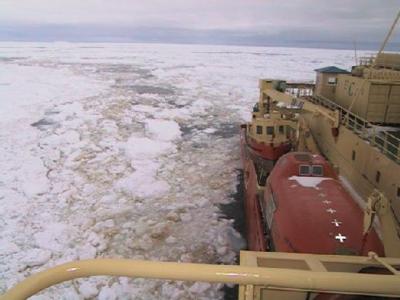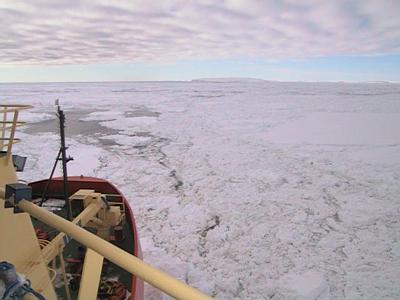
|
|
21 February, 2000
Backing and Ramming
February 21, 2000
74 15 s
141 20 w
(Off Hobbs and Ruppert Coasts of Marie Byrd Land
10:30 PM, Overcast, dark except for orange glow on the horizon.
Wind out of the east at 8 mph, temperature 17 F
All day today we've been trying to work our way east along the
Antarctic continental shelf, towards the Amundsen Sea and Pine Island Bay.
Our path has been a meandering one. In pack ice conditions one doesn't just
set a course and follow it, as you would in open water. The trace of our
course looks like the path of a mouse investigating a new cage!
Earlier today I was up on the bridge. Around us was an almost
unbroken expanse of white ice pack, mostly last winter's ice. I saw
occasional tall icebergs, and a very few dark cracks, called leads, of open
water or thin new ice. It looked like the ship was in the middle of an
endless snow covered field, with a few hills and streams. If I had my
snowshoes, I could travel miles.
Near the big bergs there is often an interesting pattern in the sea ice.
What you observe is a trail of broken ice leading away from the berg, a lot
like the broken ice ribbon behind the ship. It's as if the berg, like the
ship, was sailing through the pack ice under its own power! Of course bergs
don't have diesel engines, so why do they leave tracks as if they are
moving? I think I've got an answer. Write me and tell me what you think.
Incidentally, some of the biggest bergs may be big enough to be scraping
or stuck on the sea floor, even though the water is over a thousand feet
deep. About one sixth or one seventh of a berg is above water. A berg
showing 150 feet above the water might be big enough to be grounded. Some
of them look that high. If I had a handy little submarine I could go down
and look. I guess the submarine would have to have a bright light, because
it is pretty dark down there. Some whales and seals dive that deep looking
for lunch. We saw a whale, maybe a Minke, surface briefly in an open crack
today, a shiny black back in the bright white ice. If I could speak whale
I'd ask it (her? him?) to follow the side of an iceberg down, and see if
there was space to swim between the ice and the sea floor.
Regretfully, we have temporarily given up trying to follow the continental
shelf break (see last journal entry.) The ice won't allow it. Now we are
just trying to reach a more open area of the pack ice, so that we can get
eastward to our prime objective, Pine Island Bay and the Amundsen Sea area.
We'll try to get there by whatever route we can.
It has been slow going today, and several times we've been forced to resort
to backing and ramming. The ship goes forward until stopped by the ice, and
then backs up for a tenth of a mile or so. Then it's full speed ahead, pick
up a little momentum, and smash into the ice again. Sometimes it only takes
a crunch or two to get to the next patch of easier ice, but a couple of
times we were at it for a half hour. The noise of the engines and the ice
breaking is impressive, as is the rolling of the ship. When the propellers
hit pieces of ice, the whole ship shakes and things rattle. One time, while
we were butting the same place over and over, two emperor penguins stood
some distance away watching. I wish I knew what they were thinking!
Near the stern of the ship is a room called the aft control room. The
controls for various winches, and a lot of other levers and dials are
located there. I don't touch any of them. Most of the time the aft control
room is not in use, so I go back there to play my fiddle. It's very
important to be respectful of other people on a ship, and I don't want to
annoy anyone with my squeaking and screeching. I like this room because it
has a splendid view. I was fiddling away this afternoon watching the rush
of water from the ship's two big propellers as we rammed ice. The thrust of
the props, and the ice lifting the bow pushed the stern down. The torrent
looked like river water rushing through rapids during spring melting. Car
sized chunks of ice came out from underneath the stern, turning over and
over, while the water built up against the floes on either side.
Speaking of having a view, I've been learning about views from space. Of
course we would like to know where there is open water or looser ice, so
that we can get further east. We can see a lot from the ship's bridge, and
even more if we climb up into the ice tower above the bridge, a cozy little
crow's nest reached by three ladders. Still, we are in such a big field of
ice that getting a little higher doesn't help much. A helicopter would be
great, but it stayed at McMurdo. To the east, near the horizon, the clouds
have dark bottoms. I'd like to ask the crew if that means water, but they
seem busy and I don't want to bother them.
What I do have is some satellite images. Dr. Shusun Li of the University of
Alaska at Fairbanks is aboard. As I mentioned earlier, part of his task
here is to help "ground truth" or interpret ice images from a new orbiter.
He and his group dig pits on ice floes to study the structure of the snow
and the ice. They also have some other fancy instruments they use, which I
mean to learn about. I want to go out and work with them soon if I can.
Dr. Li showed me two kinds of images we can receive on ship, which help us
find our way. One is simply a black and white picture from space. The other
is a microwave image, made by a satellite bouncing 85 GHz radar from space.
On both of them, I can see a clear area to our east. The prevailing
easterly winds have blown all the ice to the west side of Wrigley Gulf
(where we are), while the east side (where we want to get) is ice-free. The
clear area on the images can't possibly account for the dark sky I see,
because it is much too far away. So much for my theory!
I asked Dr. Li about the advantages of one type of image over
another. Why do we need microwave radar when the regular photos show things
so clearly? He pointed out the obvious answer. Microwaves can see through
clouds and at night. In Antarctica, there are lots of clouds and six months
of darkness, which means a lot of times with no visible light image
possible. The problem with microwave images is that microwave "light"
sometimes gives confusing information. For example, rough water can look
like snow or ice, and vice versa. I can see this in the two images I have
in front of me. They both show clear water in the same places. The
microwave image shows ice detail in a large area covered by clouds in the
visible light picture. But the microwaves also show a large open water area
sixty miles inland from the coast of Antarctica, up on the ice cap, where
there couldn't possibly be a lake! These images must be available on the
Internet. Does anyone know where?
We are now back tracking, trying to find an easier way to the Amundsen Sea.
I'll keep you posted.

Dana Naber ping editing. So far he has more pings to his credit than any one else. There is an unspecified prize for the high pinger at the end of our trip. The computer is in a box so it won't slide around when the ship rolls. You can see some curved lines on the computer screen. They are the pings.

Looking back where we've been. It doesn't take long for the trail to fill in and freeze. The red thing with the crosses is a covered life boat. The brown color of the broken ice comes from diatoms.

The Nathaniel B. Palmer in thick pack ice. It is slow going. The berg in the distance might be grounded, although the water is nearly 1000 feet deep.
Contact the TEA in the field at
.
If you cannot connect through your browser, copy the
TEA's e-mail address in the "To:" line of
your favorite e-mail package.
|
